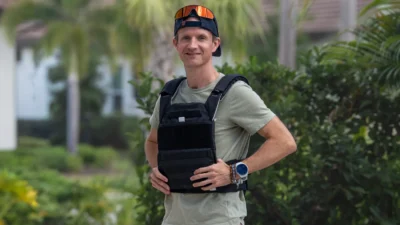Here’s how I treat running blisters when I am unfortunate enough to get one during a run.
How to treat running blisters during a run
Firstly, I determine whether the blister is tolerable to the end of my race or run. If I can continue without:
- a significant impact on HOW I am running
- significant pain with every step
If I can tolerate it, the best thing I find is to just push on to the end, without taking off my shoes or stopping – as the sooner you get to the end, the sooner you can stop running on your sore feet, get proper treatment and a change of socks/shoes.
Do I have the items I need on me to treat running blisters during a run?
The answer is pretty much always ‘yes’, as I carry in my race vest a small blister kit (often mandatory kit for long trail races in any case).
Carrying this kit means that I know that I could, if I had to, stop, take my socks and shoes off, clean and treat my feet.
I strongly recommend that anyone running a trail marathon distance or longer carries these things with them:
- a small resealable plastic bag (to carry the bits in)
- a single wrapped disinfectant wipe
- a gauze pad
- a plaster or two
- a compeed patch (‘second skin’)
- Micropore tape
- strips of inelastic, high adhesion tape (such as ‘Leukotape’)
- a clean safety pin (sterilised eg with boiling hot water before putting in the bag)
- a tissue


How to use these items to treat running blisters
The treatment may vary depending on where the blister is, but the principle is the same:
- Clean the area before treatment and avoid touching it with anything dirty, including your hands
- Remove most of the fluid as hygenically as possible to relieve pressure causing the pain
- Clean the area (again)
- Bandage up the treated blister properly to minimise the risk of getting an infection
- Do anything you can to stop the blister recurring (and stop the bandage being rubbed off and making things worse. For example, loosen or tighten your shoes, whichever is best to reduce friction.
Steps
This is what I do (and is not to be taken as medical advice – just how I choose to deal with them):
- Wipe the safety pin and affected area, then your hands, with the disinfectant wipe
- Using the safety pin, make two holes in the side of the blister, one on each side, keeping as much of the skin intact as possible (this protects the raw skin underneath)
- Use the tissue (rather than your finger) to gently encourage the liquid out of the holes – by pressing on the blister with it and soaking up the fluid. Don’t press too hard! Make the holes bigger if you need to to help get the liquid out
- When most of the fluid is out, choose whether to cover the blister with a Compeed patch, then a piece of tape over the top, or to cover it with a plaster/gauze and tape.
- If possible, avoid getting your feet wet or dirty for the rest of the run (may be easier said than done!).
I find a piece of medical gauze (shiny side down) tightly strapped to the foot using first Micropore (medical) tape, then a wide strip of tough Leukotape (or similar), is the best method of bandaging – or switch out the gauze for a plaster, if the blister is small enough for a plaster to be sufficient.
I’d only use Compeed if the blister is so bad that I need to cover it with a ‘second skin’. The reason being, that once on, you can’t pull a Compeed off without pulling on the skin around it, so you have to be confident that you want to go down that route and that the patch will stay put, otherwise it’s game over!
In summary
I should probably advise that you’re better off seeing a specialist to sort out your blister problem than just doing as I do, but I hope that if you are unfortunate to have to treat running blisters on-the-go without access to medical attention that these tips are helpful!
If you found this useful then you can also check out our other posts in our “Trail Runner Problems” series by clicking on the Trail Runner Problems tag, below.
We’d love to hear from our readers any other tips or advice you have for people suffering with blisters – please share them in the comments section below!
This post is part of our new “Trail Runner Problems” series! If you like this post, why not check out some of our other posts and subscribe by going to trailandkale.com/newsletter to receive future post updates via email, including our upcoming posts on how to deal with other Trail Runner Problems!
Comments are closed.




All great tips! I think I can use the same questions for all my backpacking 🙂
Alicia @ http://www.girlonahike.com